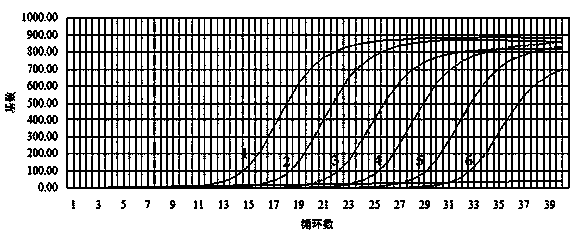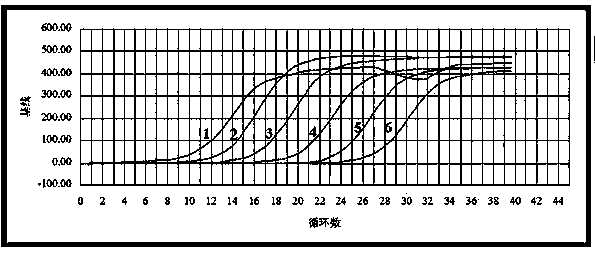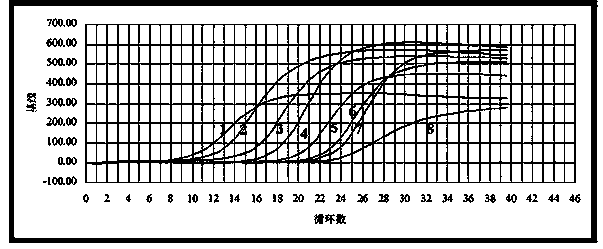Fluorescent quantitative PCR detection technology of brassicaceous vegetable plasmodiophoromycetes, and its application
A cruciferous vegetable and fluorescence quantitative technology, which is applied in the field of fluorescence quantitative PCR detection, can solve the problems that the detection method is not fast enough and cannot quantify Phytophthora rhizogenes, and achieves the effects of good practicability, rapid detection and high sensitivity
- Summary
- Abstract
- Description
- Claims
- Application Information
AI Technical Summary
Problems solved by technology
Method used
Image
Examples
Embodiment 1
[0039] Embodiment 1: the specific primer detection of clubroot
[0040] Using common soil-borne pathogenic bacteria in the rhizosphere microorganisms of cruciferous vegetable crops as materials, the primer pairs PBF2 / PBR2 and PBF3 / PBR3 of clubroot were specifically detected. The swollen roots of cabbage were stored in a -20°C refrigerator. Other soil-borne pathogenic fungal strains were cultured with PDA or PD liquid medium. All the strains were first activated on solid medium, and then transferred to liquid medium for culture. One week later, the hyphae or cells were collected to extract DNA. DNA was extracted using a modified CTAB extraction method.
[0041] Using the genomic DNA of Plasmodium brassicae and other pathogenic fungi of soil-borne diseases as templates, the primers PBF2 / PBR2 were used for ordinary PCR amplification to test the specificity of the primers. The general PCR reaction system is as follows: total reaction volume 25 μL, 10×PCR buffer 2.5 μL, dNTP (10...
Embodiment 2
[0046] Embodiment 2: Detection of root clubroot inside the cabbage growth period
[0047] In early September 2012, samples were taken at the experimental base of Qingdao Academy of Agricultural Sciences during the growth period of cabbage. The samples were the roots of cabbage 15 days after planting in the field with clubroot disease. In addition, the roots of plants that did not show symptoms of disease were taken, and the samples were washed repeatedly to ensure that there were no dormant spores of Plasmodium spp. on the surface of the samples. The DNA was extracted and purified using (MP Biomedicals, USA, FastDNA SPIN Kit for Soil). The DNA of each root was dissolved in 30 μl TE buffer, and 2 μl of the DNA solution was taken as a template, and the primer pair GZ10 / GZ11 was used for PCR detection of each sample, and the amplified product was detected by 1.5% agarose electrophoresis. PCR detection.
[0048] The products amplified by common PCR show no bands on the agarose ge...
Embodiment 3
[0050] Example 3: Soil sample detection of natural disease in the field
[0051] In areas where clubroot of cruciferous vegetables in our country has serious incidence, during the field disease investigation from July 2011 to July 2012, the soil with natural disease in the fields of Hubei, Yunnan, Guizhou, Qingdao, Sichuan, Chongqing and other places was collected Samples, a total of 60 soil samples were collected, 32 of the 60 soil samples were seriously diseased fields, and these fields had been planting cruciferous vegetable crops before 2011, and 20 were lightly diseased fields, and these fields were planted with cruciferous vegetables The vegetable crops in the family were not more than 3 years old, and 8 of them were fields without disease symptoms. The previous crop was Chinese cabbage. Most of the crop varieties cultivated in these areas were susceptible varieties. The soil samples taken from the field were immediately stored in a -20°C refrigerator, and freeze-dried d...
PUM
 Login to View More
Login to View More Abstract
Description
Claims
Application Information
 Login to View More
Login to View More - R&D
- Intellectual Property
- Life Sciences
- Materials
- Tech Scout
- Unparalleled Data Quality
- Higher Quality Content
- 60% Fewer Hallucinations
Browse by: Latest US Patents, China's latest patents, Technical Efficacy Thesaurus, Application Domain, Technology Topic, Popular Technical Reports.
© 2025 PatSnap. All rights reserved.Legal|Privacy policy|Modern Slavery Act Transparency Statement|Sitemap|About US| Contact US: help@patsnap.com



